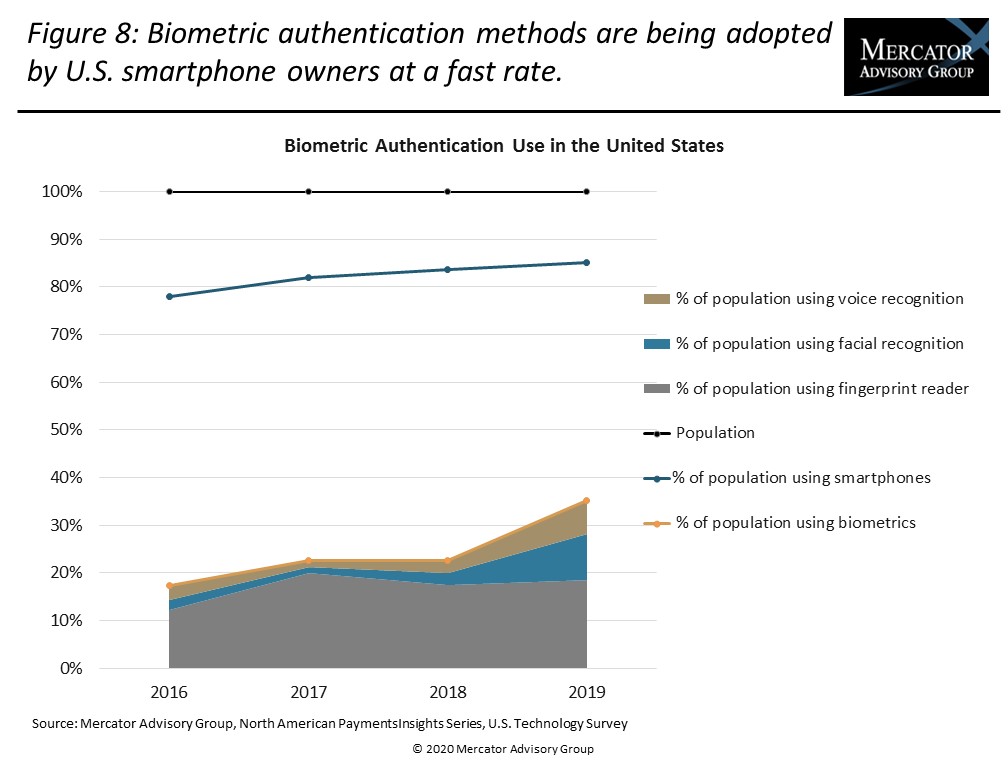Overview
In recent years, user authentication based on biometrics (biometric authentication) has become a new method for consumers to open their smartphones and select mobile apps. Mercator market research indicates biometric use is increasing even as consumers adopt a greater variety of methods choosing among fingerprint, facial recognition, and voice recognition. Biometrics are important because they utilize new mobile security hardware and software to revamp authentication, lower the risk of fraud, address the mandates of the European Union’s revised Payment Services Directive (PSD2), and induce changes in consumer behavior.
Mercator Advisory Group’s latest research report, Biometrics: Driven by Standardized Authentication, Adopted by Consumers, provides consumer sentiment, adoption rates, and forecasts on biometric authentication methods, both to unlock smartphones and for payment authentication. Additionally the report examines the FIDO Alliance, discussing how it has standardized authentication and the implications for biometrics and payments.
“Authentication using biometrics is rapidly being adopted by consumers, in part as a result of hardware manufacturers enabling its use, and in part because the standard for authentication created by the FIDO Alliance has increased the ease with which authenticators can utilize the mobile biometrics over the web and decrease authentication friction for consumers,” comments David Nelyubin, Research Analyst at Mercator Advisory Group and co-author of the report.
This research report has 16 pages and 9 exhibits.
Companies and other organizations mentioned in this report include: Android, Apple, BlackBerry, Google, FIDO Alliance, Microsoft, Mozilla Foundation, NXP, PayPal, Samsung, W3C, and Yubico.
One of the exhibits included in this report:

Highlights of the report include:
- Historical data, forecast, and analysis (2013–2024) of consumer use of biometric authentication methods (facial recognition, voice recognition, fingerprint) in total and by smartphone brand, based on Mercator Advisory Groups annual survey of 3000 U.S. adults.
- Biometrics methods for payment authentication (2016–2019) preferred by U.S. payment app users and analysis of results.
- Explanation of multifactor biometrics and the role that biometric methods play in the overall authentication process.
- Discussion of FIDO Alliance standardizing authentication, the effects on biometrics, and implications for payments and payments players and authentication in general.
Book a Meeting with the Author
Related content
2025 Emerging Biometric Authentication at the Point of Sale Scorecard
This inaugural Javelin Strategy & Research scorecard assesses the emerging market for biometric authentication at the point of sale and identifies three Pillars in this emerging te...
2026 Emerging Payments Trends
In emerging payments, hype comes first, often well in advance of the actual broad use of the payment tools and technologies. In 2026, after a year of press releases heralding the t...
Digital Money Comes to Payments, but the Crypto Has Disappeared
Digital money has come to payments, but the now isn’t the future that was once envisioned. “Cryptocurrency”—the word and the experience—is receding, and moving value through digita...
Make informed decisions in a digital financial world